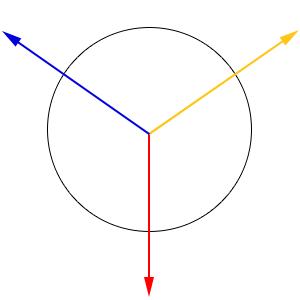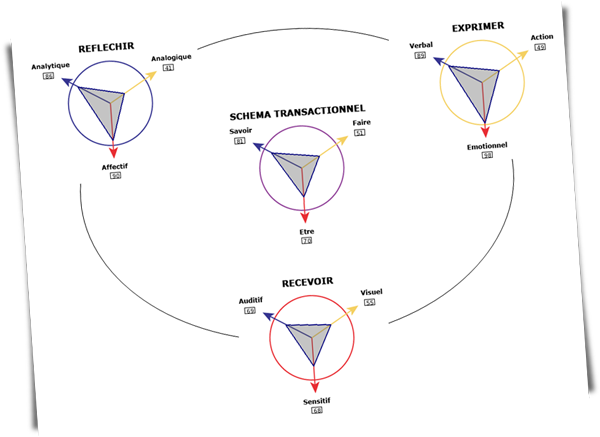The main points
To better understand and anticipate
human behaviour
In communication and human relations, the SIC® model ranges from simple to complex. A rhetorical tool, it presents your communication and relationship system. It allows you to identify what is effective in communication, your creative dynamics, and highlights your conflict risks.
It is based on geometric logic. Combined with the three colours and the resulting chromatic variation, it graphically represents:
- the three major predominances
- the three systemic patterns
- the three types of relational structures
The exclusive and cross-cultural model, presents the 13 most characteristic types of communication, with their multiple variations.
With the SIC® model,
the essentials of human communication
The Study of Structures and Interactions in Communication – SIC® is different from a test.
It is more of a survey that gives back to each person the way they define their mode of information reception, processing and expression.
The result is a fine and nuanced modelling of the different aspects of human communication.
History
The result of thinking about
the logic of human communication
This exclusive modelling has been developed by Jean-Louis Lascoux since 1991. It was conceived as a systemic model based on the Shannon and Weaver (1948) model. It has been enriched by work in pedagogy and reflections on discoveries about human brain functioning.
The SIC® model benefited from the extrapolations on human communication of the 1970s and 1980s and their representations aimed at self-knowledge and knowledge of others.
Fine and geometric
The model is based on a triangular and tetrahedral representation, presented in 1981-82, notably in a geometry working group at the University of Paris VI by Jean-Louis Lascoux, as part of a more global research on the properties of the Möbius strip.
This model was used to render a picture of ways of communicating. The triangle, which is the simplest of geometric figures, suffices. That is why the triangle is the basis of this model. The systemic declination is a matter of logic.
Vectors are placed on each triangle. Graduated from 0 to 100, these vectors, called axes, represent the use of each of the modalities for receiving information. Another triangle represents the modes of information processing and a third for transmission. The fourth triangle of the model is an average resultant of the first three. It is called the transactional schema and encompasses the Communication Structures and Interactions – CIS® of a person.
For the transactional scheme, a verb has been assigned to each axis.
- On the left axis (blue): the verb Know
- On the central axis (red): the verb To be
- On the right axis (yellow): the verb Do

Validation
A tool for understanding
and relational anticipation
The SIC® Study has been tested with several populations. From 1991 to 1994, it was used in several project support training courses financed by the Ministry of Labour and the Direction Départementale du Travail, de l’Emploi et de la Formation Continue de Paris. These actions allowed us to experiment, then to validate this exclusive tool, used in contexts of great difficulty for the people.
The SIC® Study was able to be validated during this work. It facilitates a better understanding of the participants’ communication modalities. It allows, through pedagogical support, an appropriation of communication techniques, project definition and teamwork. It is a powerful instrument for relational anticipation.
A tool for your creativity
and conflict prevention
The calculation system has been validated with a public coming to training with the objective of defining and consolidating a project. More than 2,000 SIC® studies have been carried out with people whose educational background ranged from level V to level I, from all professional and cultural backgrounds and in contexts of social exclusion, professional integration and team or company management.
From 1991 to 1998, more than 5,000 people responded to the SIC® Study.
Since 1999, because of its specificity to work on conflict dynamics, the SIC® Study has been reserved for the training of professional mediators.
The Model was used by Jean-Louis Lascoux to structure all the tools of relational engineering.
The three communication patterns
| THE DIAGRAMS | Left axis | Central axis | Right Axis |
|---|---|---|---|
| Reception diagram | Auditory | Sensitive | Visual |
| Reflection diagram | Analytical | Affective | Analogical |
| Emission diagram | Verbal | Emotion | Action |
The SIC® model answers the question: what is an I? It presents a system of information reception, processing and emission combined with a potential state of consciousness.

with different axial meanings
In order to simplify and implement a global approach, these three schemes result in a so-called transactional scheme. It is calculated from the other three. The average score of each axis is assigned and it is from this transactional scheme that the SIC® typology is represented on the color wheel.

| Left axis | Central axis | Right axis | |
|---|---|---|---|
| Transactional diagram | To know | To be | To do |
Thus, an “I” is a claim to consciousness with a set of statements in terms of receiving information, processing information, and expressing information.
The CIS® model highlights the potential for mismatches that exist in your Communication Structure:
- between your intentions and your actions
- between your actions and how they are perceived
- between what you perceive and the information you process, as well as how you do it.
The power of this model is that it is first and foremost, more than identifying Structure and Interactions in Communication – SIC®, a model geared toward pedagogy and improvement.

The thirteen typical patterns
The model is about logic. It stages the logic of human communicative functioning. The simplest geometric representation, the triangle, allows us to attribute to it the relationship with the three basic colors: blue, red and yellow. To each predominance corresponds a shade of color. As a result, each pattern has a precise place on the color wheel of the SIC® model.
The modeling yields a typology of 13 patterns from the results obtained on the transactional pattern.
These typical patterns are identified according to the characteristics they represent in the communication specializations. Three patterns are highly typed:
- the left-axis specialized pattern, with the two identical right-axis and center-axis scores: 1.2.2.
- the center-axis specialized pattern, with the other two identical scores: 2.1.2.
- the right-axis specialized pattern, with the other two identical scores: 2.2.1.
To understand the meaning of the codes assigned to each of the patterns, the number 1 should be assigned to the highest score, 2 to the second score, and 3 to the third. In case of a tie, if two scores are the same, either 1 or 2.
So, the highly specialized patterns are the three mentioned above, which are easy to identify since they also correspond to the basic color:
- 1.2.2.: blue
- 2.1.2.: red
- 2.2.1.: yellow
Overall, the color wheel of the SIC® model can be observed according to:
- the blue part contains rational, verbal, and auditory functionings
- the red part contains affective, emotional, sensory functionings
- the yellow part contains analog, active, and visual functionings
A 90-item questionnaire
90 items to define
your Structure and Interactions
in communication
90 items were listed to model the Structure of Communication Interactions – SIC®. A score was assigned to each, combined with weighting indices that take into account the cross-tabulation of responses.
The calculation system has been validated with an audience coming for training with the objective of defining and consolidating a project. More than 2000 SIC® Studies were conducted with people whose education ranged from level V to level I and from all professional and cultural environments.
The scoring and calculation system of the SIC® Study was tested for one year. Semantic adjustments were made to facilitate access to different levels of conceptualization.
The results of the SIC ® Study are rendered on a graphic modeling of three vectors, called axes. They result in a graphical representation of the three patterns of human communication:
- reception of information
- reflection of information
- emission of information
Specificities of the SIC® Study
The Structure of Interactions in Communication – SIC® model graphically represents the three-dimensionality of human communicative functioning. An overlap can be made with some studies used in recruitment, which blend the characteristics of receptivity, reflexivity, and expressivity.
The Study of the Structure of Interactions in Communication – SIC® is a personal enrichment approach. It is aimed at improving communication skills. It is the only study to offer rhetorical work, that is, work on the participants’ oral and verbal communication.
